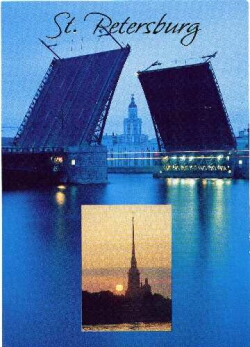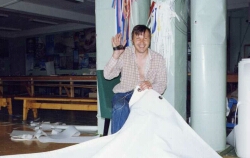|
|
St Petersburg
We started 17 june -93, a week prior to the Midsummer celebrations,
and sailed through Åland and the Finnish archipelagos and got
to Kotka. That year the summer came late so the weather was cold and
wet. We got a real good wind form Kotka as our journey to Russia began.
At the border of the Russian territorial waters we met a coastguard
boat. We were not registered by any authority, I only had a three month
tourism visa. Our destination in St Petersburg was a small yacht club
called Strelna. We told the coastguard that the club was awaiting us
and that this information had not yet reached the authorities. After
1,5 hours of discussion they let us go as we promised dearly and honorably
to register ourselves as soon as we got to the customs, if not the coast
guard would fin them. (Our improvisation had now begun). The customs
took us some 15minutes to get past and we headed for the Strelna yacht
club.
The markings of Russia had been both good and detailed, but in later
years both colors and sometimes even some beacons were missing. Our
description to Strelna was:
Go back to the fairway from the big port, and after 2 kilometers turn
left. You should after a while see a building in aluminum and a chimney
that forms a leading line, when there is about one kilometer left one
should see two markings at the harbor which leads you to the fairway
and finally to the Strelna yacht club. The trip went well, but I recommend
people who travel between Kronstadt and St Petersburg to travel with
someone with local knowledge.
|
|
|
|
At Strelna we were met by my father in law who had much experience
with sail racing in Russia and who had many contacts in the yacht club.
Now the preparation work for the journey through the river systems began.
Russian sailors told me that the depth I always at least 4 meters and
that all bridges were at least 14 meters tall (with exceptions for the
moveable bridges). Maps and such could be bought from the Ministry of
the Russian river Fleet. In many places in Russia, people do things
by themselves, which was the case here where there was a sailmaker shop.
I bought a new mainsail for 1200kronor or converted for 200 US dollars.
|
|
|
Travel with or without mast?
One of the sailers, Anatoly Kanovalov, an old sea wolf who had spent
his lifetime sail racing and traveling the canals, who also stitched
our sail, told us the following:
The water stream through St Petersburg has the speed of about 4-5 knots
and the bridges in the inner city are only 5 meters tall but moveable.
There are eight bridges of this type and they are only open at night
time when heavy traffic passes through.
We decided to remove our mast and travel during the calm day through
St Petersburg. Just after St Petersburg there is a large footbridge,
perfect for putting the mast back in its place (as mast cranes are scarce).
The rest of the 3600km to the Black Sea is bridge free, with only one
bridge at the Don River. We saved that problem for later. As we were
going on our own, Anatoly arranged a crew list with stamps from the
Strelna Yacht Club. This would save us time if we ran into authorities
(never used) After a week of planning everything seemed to be in place,
but we still had some questions circulating our heads (how to use the
floodgates, if is there anywhere to get supplies amongst the way, what
if the stream is faster than 5knots etc.).
|
| Oresjek, Nöteborg, Schussenburg, Petrokrepost
The Saturday of 10th of July we brought down our mast and went along
the Neva under all of St Petersburg's bridges
…………………The first mast removal
The Neva River is 74 kilometers long, and about 30 kilometers of those
are urbanized. After 45kilometers there is a smaller part of the Neva
called Ivanovsky Rapids. The stream had the speed of 5 knots, which
was the fastest of the canal system. In other words; if we made past
the rapids, the rest of the journey should not be a problem. We successfully
passed the rapids.
. . . . . . . . . . . . .Passing the Winter Palace.
|
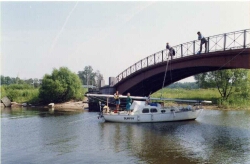
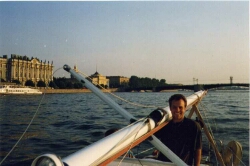
|
|
Some history about the Neva River
By the end of the Neva river we reached Schlisselburg, or in Swedish,
Nöteborg. The history of the forts begins in 1323 when it was built
by the Novgorodians to defend the inlet of the Neva. It was at first
built in wood and was named Oreshek (nut). During a siege by the Swedes
the fort was destroyed with only the stone towers still standing. It
was then rebuilt with stone. By the year 1611 the Swedes successfully
occupied the fort after 2 months of siege and named it; Nöteborg.
About 100 years later during The Great Northern War Peter the Great
reoccupied it and said; "That was a hard nut to crack". The
name was again changed but this time to the Schlussenburg (the Key city).
Today it is called Petrokrepost. During the 19th century the fort was
converted to a prison. It was at this place that Alexander Ulianov,
brother to Lenin, was executed after a failed assassination attempt
on the Tsar Alexander II.
After passing the Petrokrepost we arrived at the lake of Ladoga. We
passed the southern part of the lake to sail for the Svir River. This
took us a day and a night.
|
|
Locks in Volga-Balt
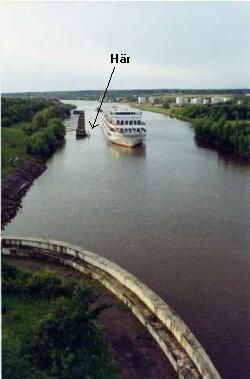
|
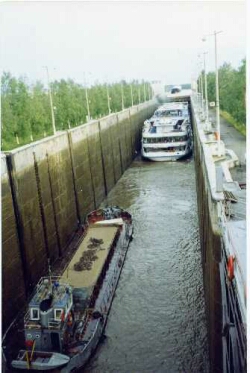
|
|
After the Ladoga the 224kilometres long Svir River begins. After half
a day of sailing it was time to pass through our first lock. I had never
done this before and the 10m high doors looked a bit threatening. We
asked a larger ship to help us an they agreed and contacted the lock
guard. He said that there would be no problem as long as we paid the
fee. We paid half a dollar (the fee was based on weight) and got instructions
to follow the larger ships and to put our boat at the very back of the
lock. It all went well, but one should be very careful when going behind
large ships as their propellers make big whirlpools behind them in the
floodgate. The time was close to midnight and we were happy to have
passed the lock without any mishaps. During the journey we established
a tradition of celebrating every long distance accomplished, or any
progress with a sandwich and something drinkable. It was surprisingly
often we had something to celebrate, but after this passing the vodka
tasted even better.
|
|
Onega - the junction to the Arctic Ocean.
Onea is a lake that works like a junction for people who want to travel
to the White Sea to the north. Both Ladoga and Onega are interesting
to sail, there are archipelagos, islands and beaches. There is the Valam
Monastery, the Kirshi Island with an architect museum and wooden houses
from northern Russia. We did not do any major trips, we wanted to go
south towards the Mediterranean Sea.
The Volga - Baltic canal - One of Stalin's labor camps for political
prisoners.
Right in the middle of the Russian wastelands there is this swamp area.
In this swamp area Stalin built a canal junction between Onega and Volga,
all built by hand (not by Stalins hand). This area is all flat and the
water is as still as it can be because of the lack of natural stream.
During the summers it gets really moist with more than 30 degrees at
night. This is an excellent environment for mosquitoes and other insects
that like to hunt warmblooded animals or us. The length of the channel
is only 368kilometres, but it took us five days to get past the swamp.
Next page
|
